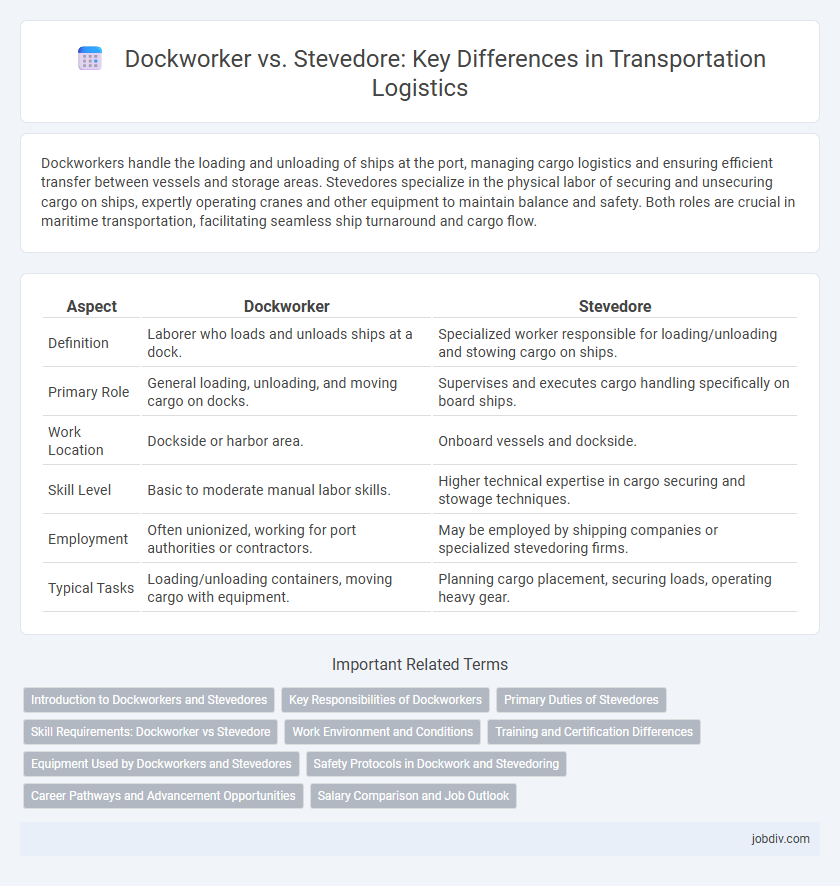Dockworkers handle the loading and unloading of ships at the port, managing cargo logistics and ensuring efficient transfer between vessels and storage areas. Stevedores specialize in the physical labor of securing and unsecuring cargo on ships, expertly operating cranes and other equipment to maintain balance and safety. Both roles are crucial in maritime transportation, facilitating seamless ship turnaround and cargo flow.
Table of Comparison
| Aspect | Dockworker | Stevedore |
|---|---|---|
| Definition | Laborer who loads and unloads ships at a dock. | Specialized worker responsible for loading/unloading and stowing cargo on ships. |
| Primary Role | General loading, unloading, and moving cargo on docks. | Supervises and executes cargo handling specifically on board ships. |
| Work Location | Dockside or harbor area. | Onboard vessels and dockside. |
| Skill Level | Basic to moderate manual labor skills. | Higher technical expertise in cargo securing and stowage techniques. |
| Employment | Often unionized, working for port authorities or contractors. | May be employed by shipping companies or specialized stevedoring firms. |
| Typical Tasks | Loading/unloading containers, moving cargo with equipment. | Planning cargo placement, securing loads, operating heavy gear. |
Introduction to Dockworkers and Stevedores
Dockworkers and stevedores are essential laborers in the transportation industry responsible for loading and unloading cargo on ships. Dockworkers primarily handle tasks on the docks, facilitating the movement and storage of goods, while stevedores specialize in managing the stowage and securing of cargo aboard vessels. Both roles require coordination with shipping schedules, safety protocols, and heavy equipment operation to ensure efficient maritime logistics.
Key Responsibilities of Dockworkers
Dockworkers are responsible for loading and unloading cargo from ships, ensuring the safe handling of goods during transfer between vessels and docks. They operate heavy machinery such as forklifts and cranes, organize and secure cargo for storage or shipment, and coordinate with shipping personnel to maintain efficient workflow. In contrast to stevedores who primarily plan and supervise cargo operations, dockworkers execute the physical tasks essential to maritime logistics.
Primary Duties of Stevedores
Stevedores specialize in the loading and unloading of cargo ships, ensuring safe and efficient handling of containers, bulk goods, and other freight. They operate heavy machinery such as cranes and forklifts to transfer cargo between vessels and docks while adhering to strict safety protocols. Their primary duties also include securing cargo for transport, maintaining accurate inventory records, and coordinating with port authorities and shipping lines to optimize vessel turnaround times.
Skill Requirements: Dockworker vs Stevedore
Dockworkers primarily require skills in operating heavy machinery, basic cargo handling, and adherence to safety protocols, making physical strength and coordination essential. Stevedores demand advanced expertise in cargo loading techniques, vessel stability, and logistics management, often requiring certifications in maritime operations. Both roles emphasize teamwork and efficiency, yet stevedores hold more specialized knowledge for complex shipboard cargo operations.
Work Environment and Conditions
Dockworkers typically operate on docks and piers, handling the loading and unloading of cargo in open and often exposed environments where weather conditions can significantly impact work. Stevedores, while also managing cargo, may work in both dockside and shipboard settings, facing confined spaces and the complexities of securing loads on vessels. Both roles demand physical strength and adherence to safety protocols due to heavy machinery, shifting cargo, and the risk of accidents in dynamic, fast-paced ports.
Training and Certification Differences
Dockworkers typically receive on-the-job training focused on equipment operation and safety procedures, often without formal certification requirements. Stevedores generally undergo specialized training programs that include cargo handling techniques, hazardous materials awareness, and may obtain certifications such as the OSHA maritime safety certification or TWIC (Transportation Worker Identification Credential). Certification for stevedores ensures compliance with international shipping standards and enhances qualification for complex loading and unloading operations.
Equipment Used by Dockworkers and Stevedores
Dockworkers and stevedores utilize specialized equipment to efficiently handle cargo at ports, including cranes, forklifts, and conveyor belts for loading and unloading ships. Dockworkers often operate yard trucks and straddle carriers to move containers within the terminal, while stevedores focus more on shipboard gear such as hatch covers and winches to manage cargo stowage. Both professions rely on safety gear like helmets, gloves, and reflective vests to ensure secure working conditions during maritime logistics operations.
Safety Protocols in Dockwork and Stevedoring
Dockworkers and stevedores both handle cargo loading and unloading but differ in safety protocols due to their specific roles; dockworkers focus on dockside equipment and vehicle safety, while stevedores emphasize shipboard operations and cargo securing. Comprehensive training in personal protective equipment, hazard communication, and emergency response is essential for both to minimize accidents and injuries. Coordination between dock and ship personnel ensures adherence to maritime safety regulations and reduces operational risks.
Career Pathways and Advancement Opportunities
Dockworkers primarily load and unload cargo at ports, specializing in manual labor tasks, while stevedores often manage and coordinate these activities, overseeing efficient cargo handling and storage. Career pathways for dockworkers typically involve gaining experience and skills to advance into supervisory or equipment operator roles, whereas stevedores may progress into logistics management or port operations leadership positions. Both roles offer opportunities for advancement through certifications in safety, equipment operation, and supply chain management, enhancing career growth within the maritime and transportation industries.
Salary Comparison and Job Outlook
Dockworkers and stevedores, both essential in cargo handling, have salary ranges influenced by location and experience, with dockworkers earning an average annual wage of $40,000 to $60,000 while stevedores typically make between $45,000 and $65,000. The job outlook for both roles remains stable due to consistent global trade demands, though automation trends could affect future employment opportunities. High-demand ports and specialized skills can significantly boost earning potential and career advancement in these transportation sectors.
Dockworker vs Stevedore Infographic

 jobdiv.com
jobdiv.com